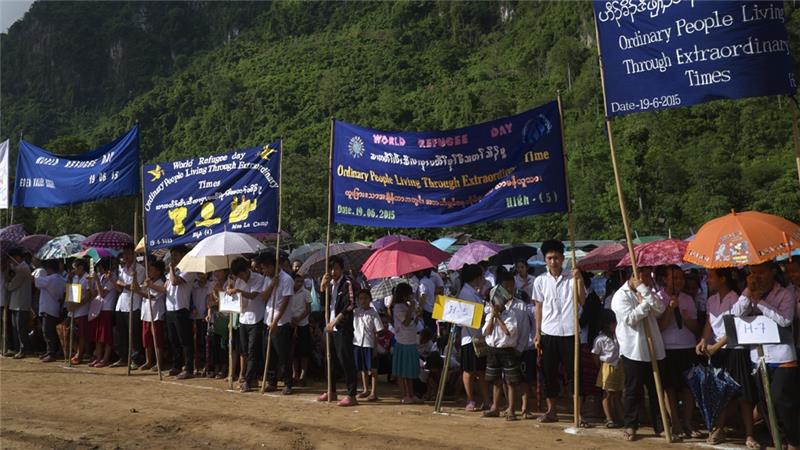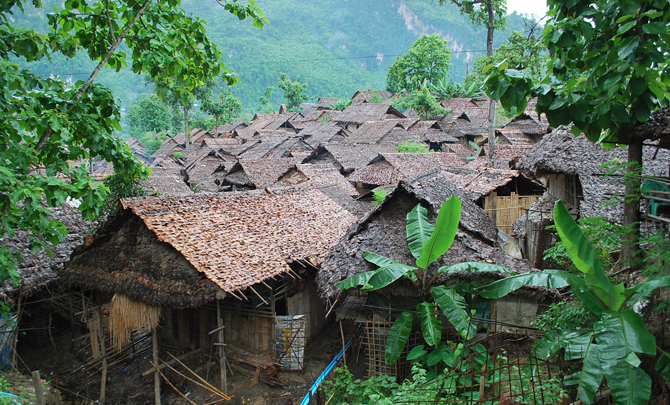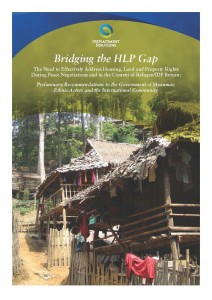Posts Tagged ‘Refugee Repatriation’ (20 found)
Submission to the United Nations Universal Periodic Review on Refugees and Displaced Persons Burma/Myanmar
1. This submission focuses on Burma’s compliance with international human rights obligations in relation to Burma’s refugees and displaced persons safe, dignified and voluntary return. It draws on interviews conducted with a mixture of semi-structured individual interviews and focus groups with refugees from Mae La, Umpiem Mai, Ban Nai Soi, and Mae Ra Ma Luang refugee camps including women, youth and religious minority groups, Mon, Karenni, and Karen civil society groups, ethnic armed groups (EAGs), refugee committees, and international non-governmental organizations […]
• • •As the Conflict in Ethnic Areas Continues the International Community and the Burma Government Must Respect the Rights of Refugees and IDPs
 Every year on 20 June, many refugees who have fled Burma due to ongoing conflict, persecution, and human rights abuses, mark World Refugee Day with a sense of uncertainty and anxiety towards their future. This year, as the rainy season begins, refugees along the Thailand-Burma border and Internally Displaced Persons (IDPs) in Kachin, Chin, Arakan and northern Shan States, as well as other conflict-ridden areas, face severe shortages in aid. Over 220,000 IDPs are in camps in northern Burma, while a further 110,000 refugees live in a protracted refugee situation along the Thailand-Burma border. If Burma hopes to make a genuine transition towards democracy it must recognize, respect, and protect the rights of refugees and IDPs […]
Every year on 20 June, many refugees who have fled Burma due to ongoing conflict, persecution, and human rights abuses, mark World Refugee Day with a sense of uncertainty and anxiety towards their future. This year, as the rainy season begins, refugees along the Thailand-Burma border and Internally Displaced Persons (IDPs) in Kachin, Chin, Arakan and northern Shan States, as well as other conflict-ridden areas, face severe shortages in aid. Over 220,000 IDPs are in camps in northern Burma, while a further 110,000 refugees live in a protracted refugee situation along the Thailand-Burma border. If Burma hopes to make a genuine transition towards democracy it must recognize, respect, and protect the rights of refugees and IDPs […]
Burma Refugee Delegation Addresses British Parliament Meeting
A delegation of refugees from Thailand-Burma border is visiting the UK this week, for a lobbying trip focusing on the situation of refugees and Internally Displaced Persons (IDPs) along the Thai-Burma border, and the need for more humanitarian assistance […]
• • •Statement on Repatriation of Refugees from the Thai–Myanmar Border
The Asia Pacific Refugee Rights Network (APRRN), a growing network of 194 organizations and individuals from 26 countries, expresses its grave concern over the recent announcement by the Royal Thai Government regarding the repatriation of refugees living on the Thai – Myanmar border back to Myanmar (Burma). While the announcement does not specify a particular date for repatriation, the intent of the announcement does raise serious humanitarian concerns […]
• • •Flurry of Rumor and Counter Rumor Regarding Repatriation is Detrimental to Refugees
 A week ago, rumors began doing the rounds that the Thai military plans to repatriate the 130,000 or so displaced persons from Burma living in nine camps in Thailand along the length of the Burma-Thailand border in the relatively immediate future. The rumors started when General Prayuth Chan-o-cha, Head of the National Council for Peace and Order (NCPO), mentioned that the refugee issue had been discussed with Senior General Min Aung Hlaing, Commander-in-Chief of the Burma Army. On 14 July, the Bangkok Post then quoted an unnamed Thai military source saying that working teams have sorted 130,000 refugees into three groups as part of preparations to send them home, a process expected to take around a year or more. A Burma Border Guard Force officer also told Mizzima on 15 July that armed ethnic groups in Karen State would allegedly cooperate in the resettlement of refugees on their return home.
A week ago, rumors began doing the rounds that the Thai military plans to repatriate the 130,000 or so displaced persons from Burma living in nine camps in Thailand along the length of the Burma-Thailand border in the relatively immediate future. The rumors started when General Prayuth Chan-o-cha, Head of the National Council for Peace and Order (NCPO), mentioned that the refugee issue had been discussed with Senior General Min Aung Hlaing, Commander-in-Chief of the Burma Army. On 14 July, the Bangkok Post then quoted an unnamed Thai military source saying that working teams have sorted 130,000 refugees into three groups as part of preparations to send them home, a process expected to take around a year or more. A Burma Border Guard Force officer also told Mizzima on 15 July that armed ethnic groups in Karen State would allegedly cooperate in the resettlement of refugees on their return home.
However, according to DVB, Colonel Weerachon Sukondhadpatipak, a spokesman for the Thai military, refuted the rumors: “I don’t think this [repatriation] will happen at this moment. It is an issue we need to solve, but it doesn’t mean we are sending the Burmese people back to [Burma],” Weerachon said. “It is a long process that needs to be discussed with all concerned parties.” Indeed, nationalities would first need to be verified and people head-counted […]
• • •Displaced Persons from Myanmar in Thailand
Recently there have been intensified interests and news circulation about the displaced persons from Myanmar in Thailand. Below are clarifications on this issue […]
• • •Shans fear repatriation to Burma
The weather is often misty and cold in the mountainous jungle surrounding Koung Jor, the Shan refugee camp located a stone’s throw from the Burmese border in Thailand’s Wiang Haeng district.
Koung Jor means “happy hill”, and dozens of Shan families were smiling widely last Sunday morning when a donation of mosquito nets arrived from the International Office for Migration.
“Their happiness at receiving new mosquito nets will soon disappear if you start asking them how they feel about repatriation. They will panic,” said 33-year old Sai Kyaw, who has been volunteering for nearly 10 years on an education program for children at the camp […]
• •Bridging the Housing Land and Property Gap
 Of the many challenging issues that will require resolution within the peace processes currently underway between the government of Myanmar and various ethnic groups in the country, few will be as complex, sensitive and yet vital than the issues comprising housing, land and property (HLP) rights. Viewed in terms of the rights of the sizable internally displaced person (IDP) and refugee populations who will be affected by the eventual peace agreements, and within the broader political reform process, HLP rights will need to form a key part of all of the ongoing moves to secure a sustainable peace, and be a key ingredient within all activities dedicated to ending displacement in Myanmar today […]
Of the many challenging issues that will require resolution within the peace processes currently underway between the government of Myanmar and various ethnic groups in the country, few will be as complex, sensitive and yet vital than the issues comprising housing, land and property (HLP) rights. Viewed in terms of the rights of the sizable internally displaced person (IDP) and refugee populations who will be affected by the eventual peace agreements, and within the broader political reform process, HLP rights will need to form a key part of all of the ongoing moves to secure a sustainable peace, and be a key ingredient within all activities dedicated to ending displacement in Myanmar today […]
KRC Position on Repatriation
Due to the ongoing civil war, ethnic armed struggle, political conflicts and military coup that took power from the civilian government and refused to give democratic rights to the citizens and carried out oppressive policies, the influx of Burma refugee to Thailand started taking place […]
• • •Will Myanmar’s War Refugees be Forced Home Against their Will?
They can’t live like this forever. Many of the 160,000 refugees evading conflict in eastern Myanmar inhabit a purgatory of thatch-roofed shanties across the river border in Thailand. Life in the United Nations-monitored camps is dreary and monotonous […]
• •








 All posts
All posts